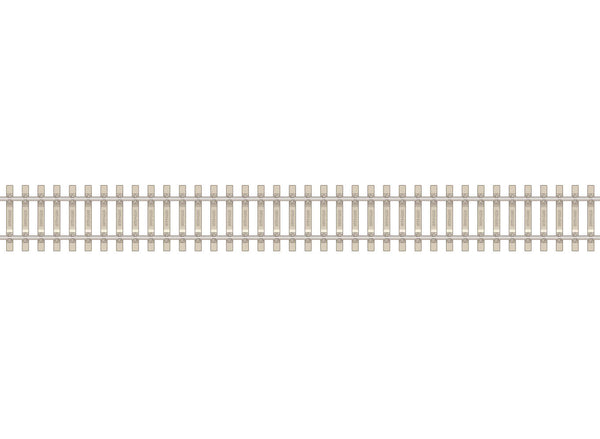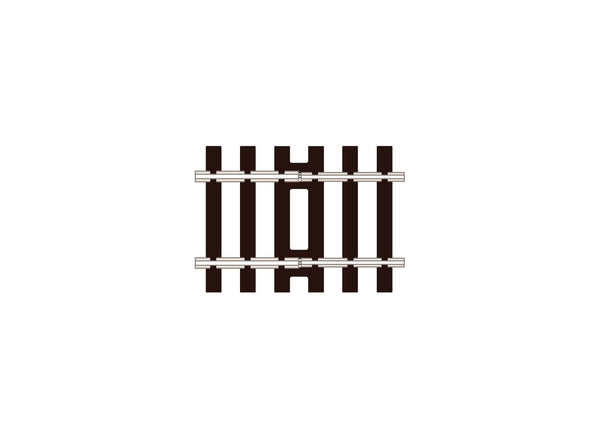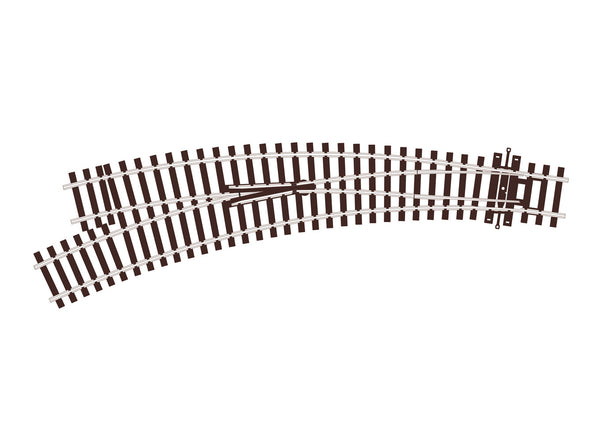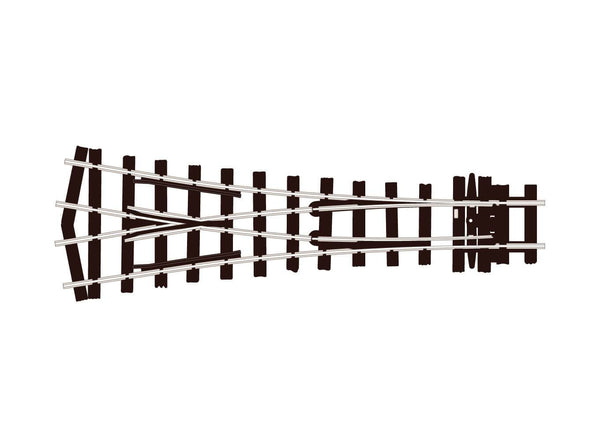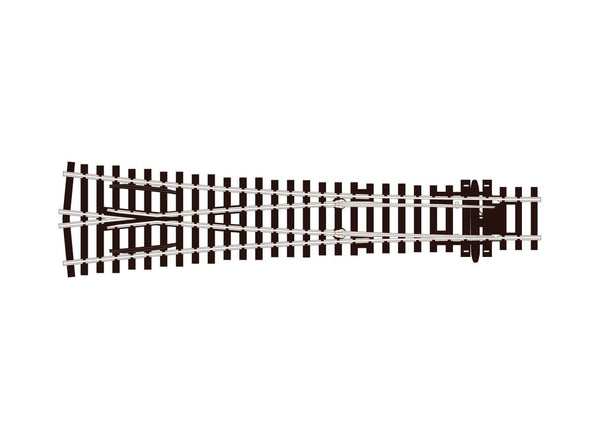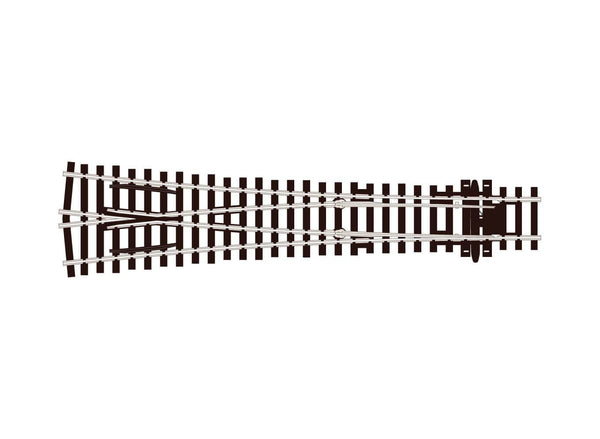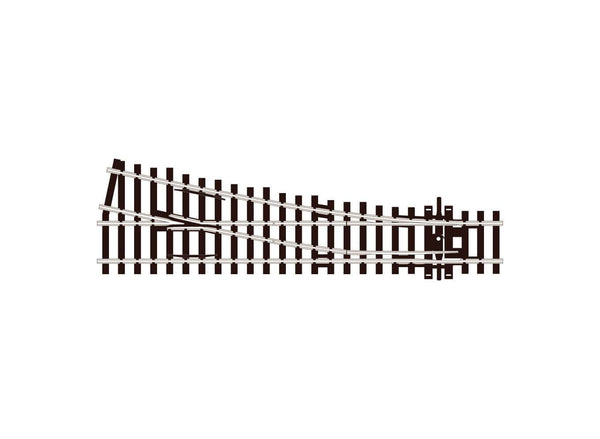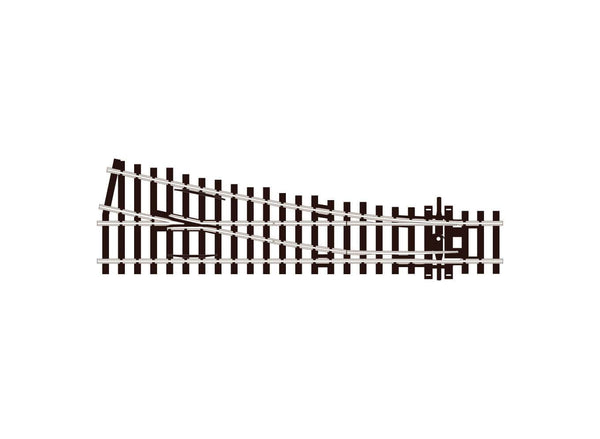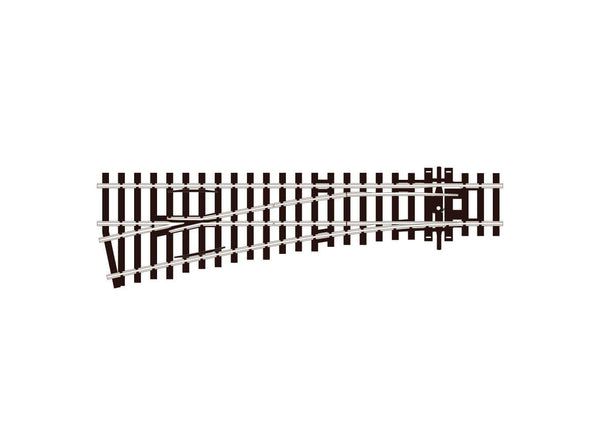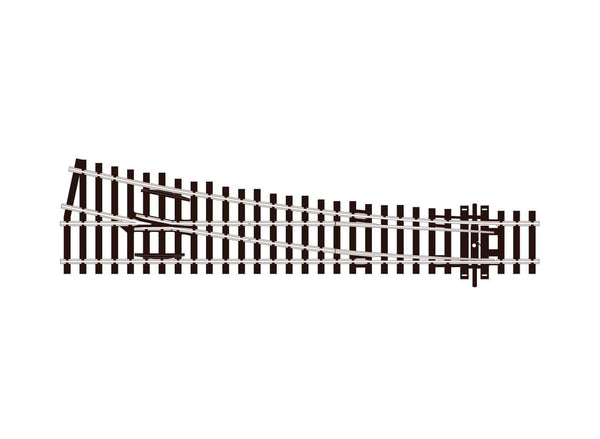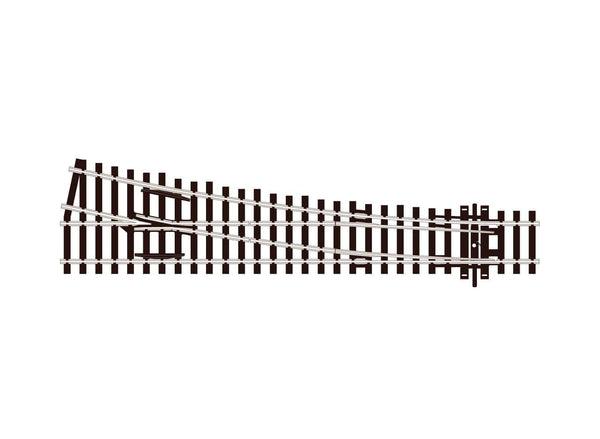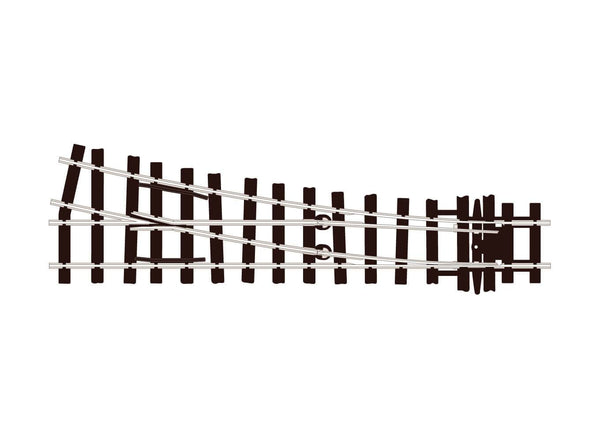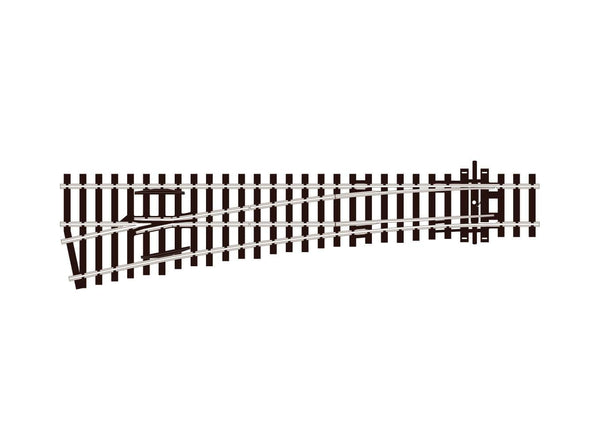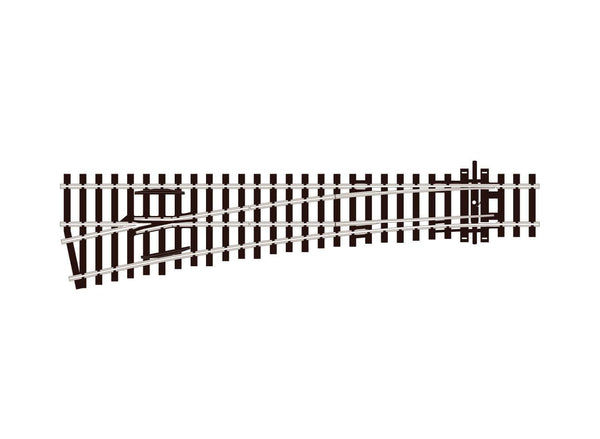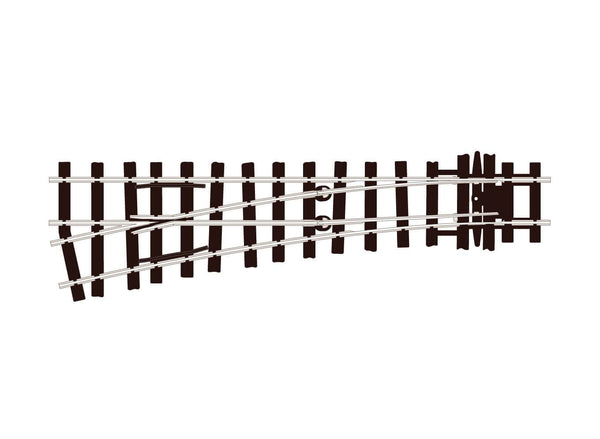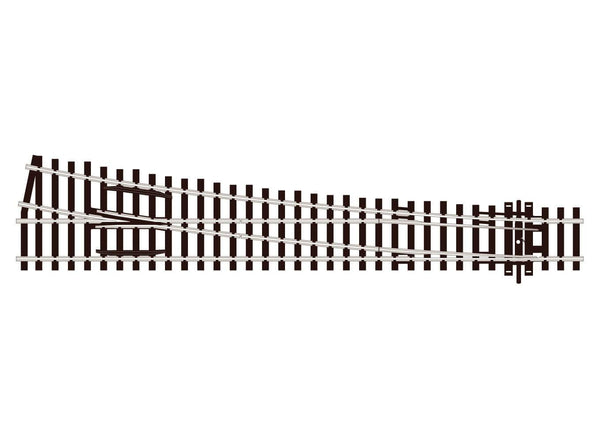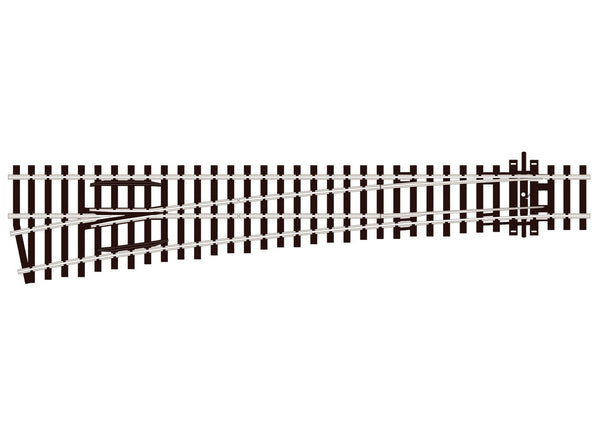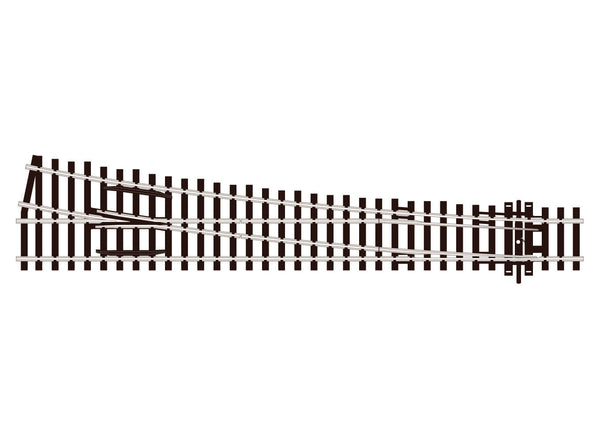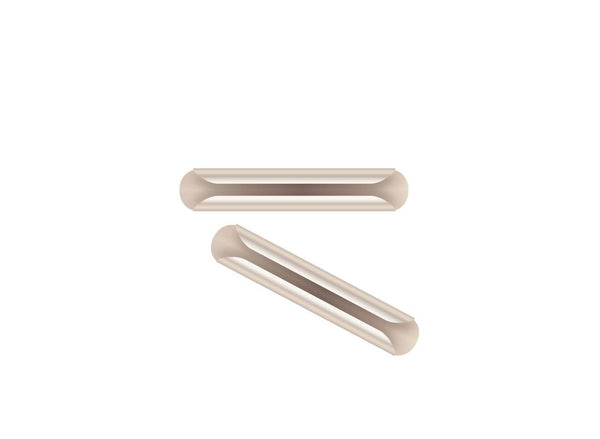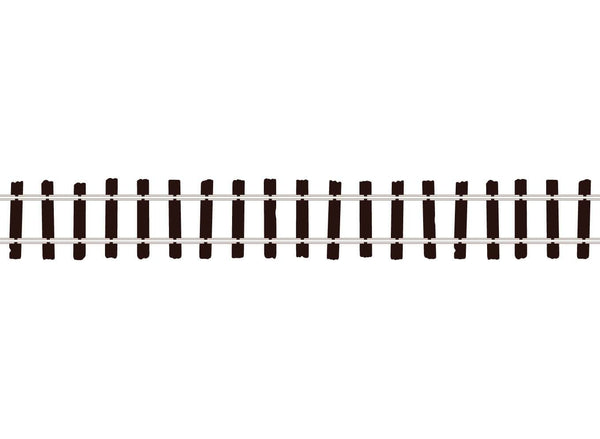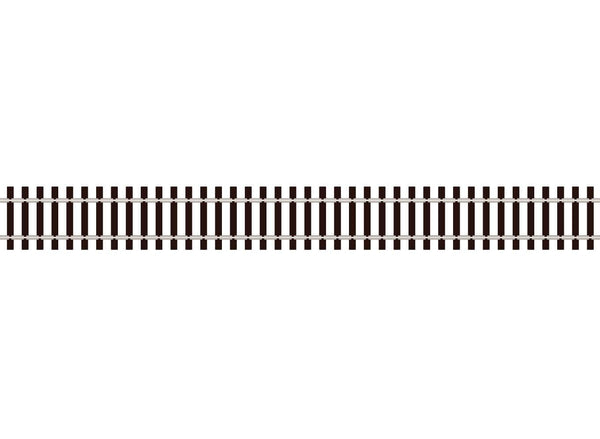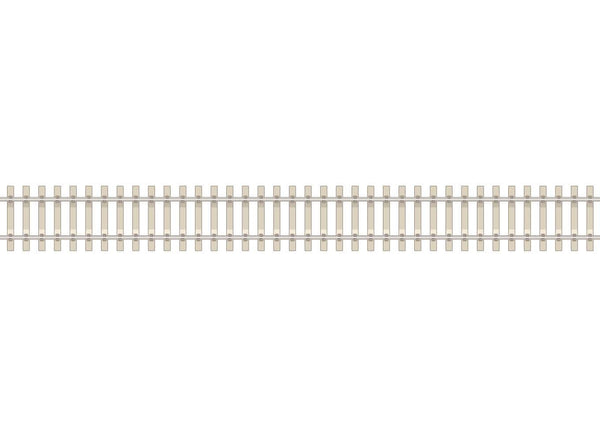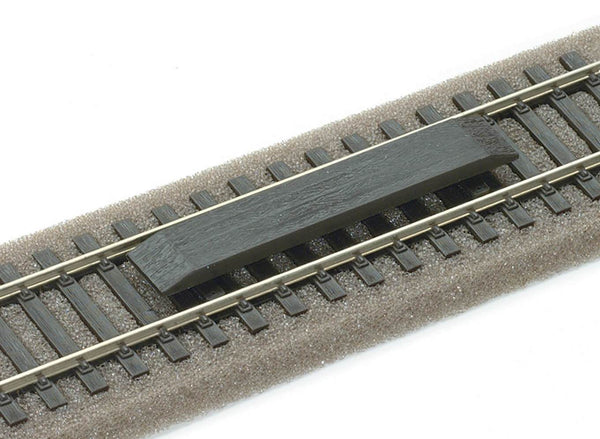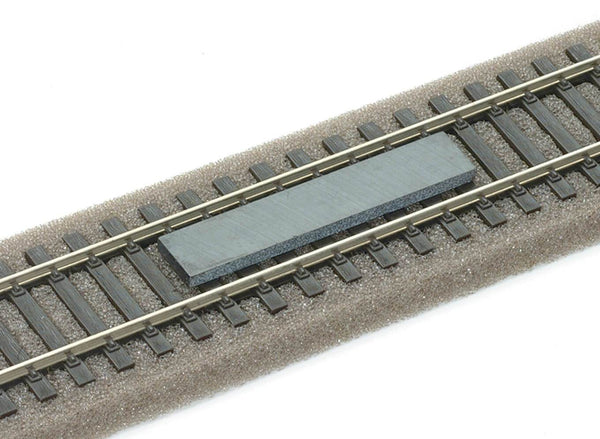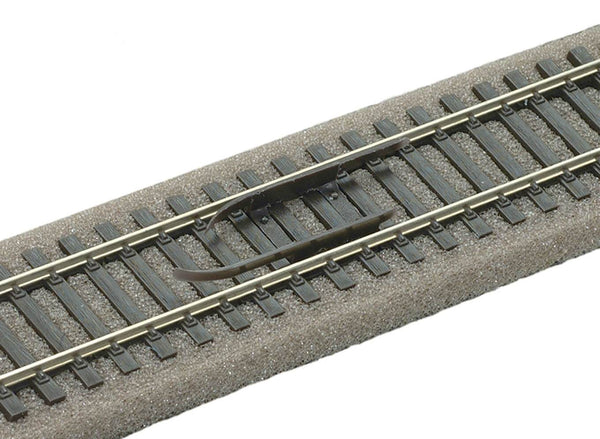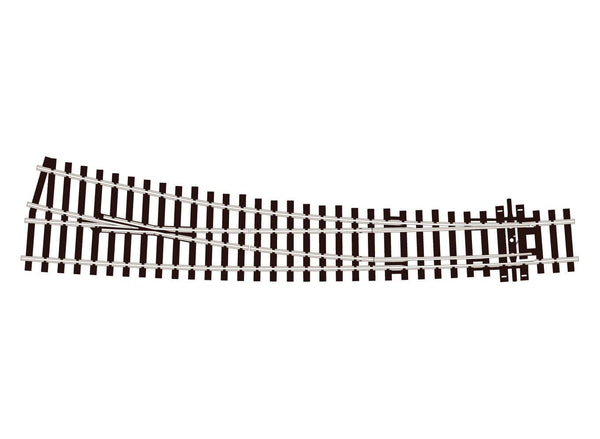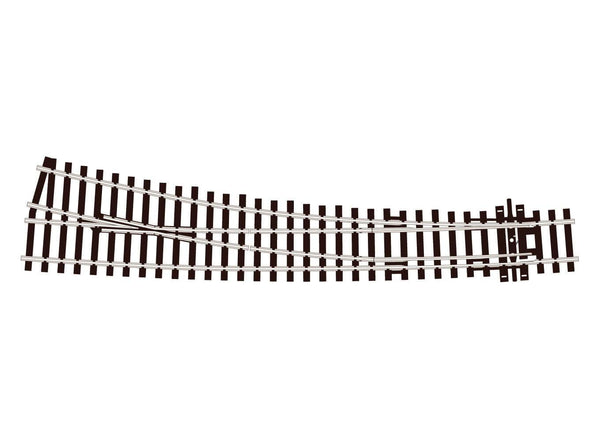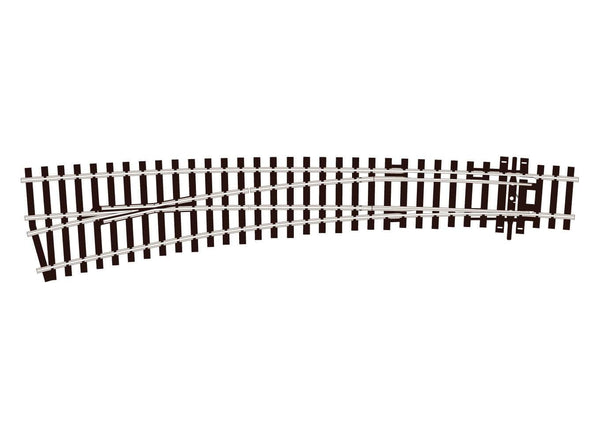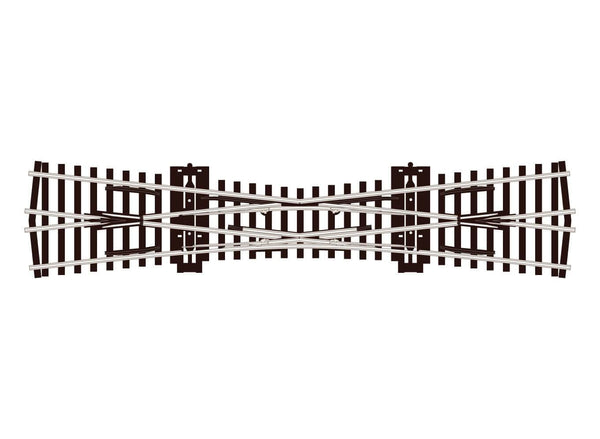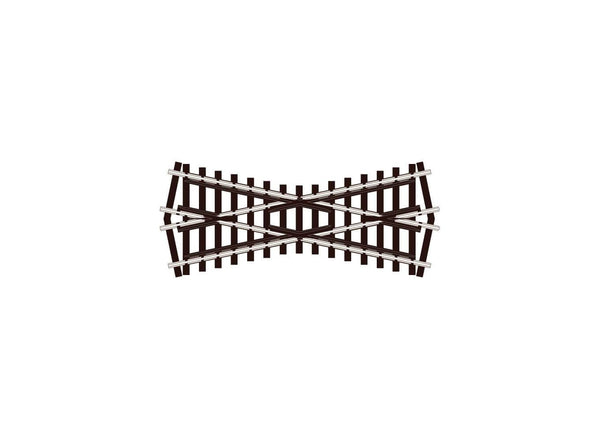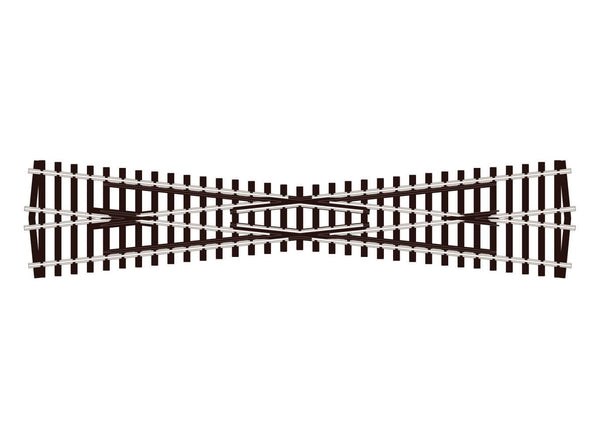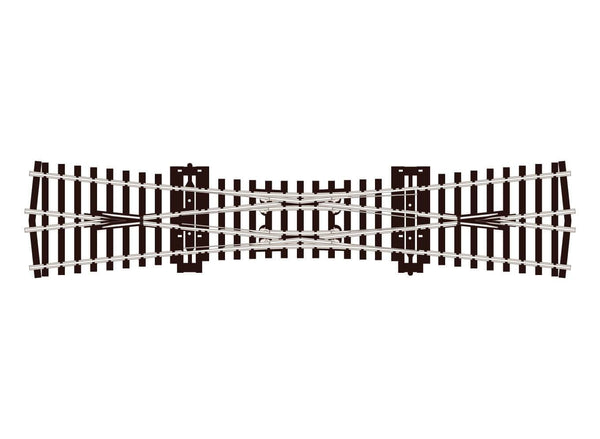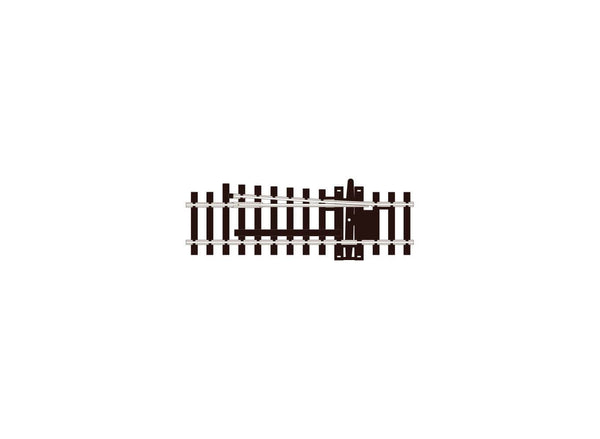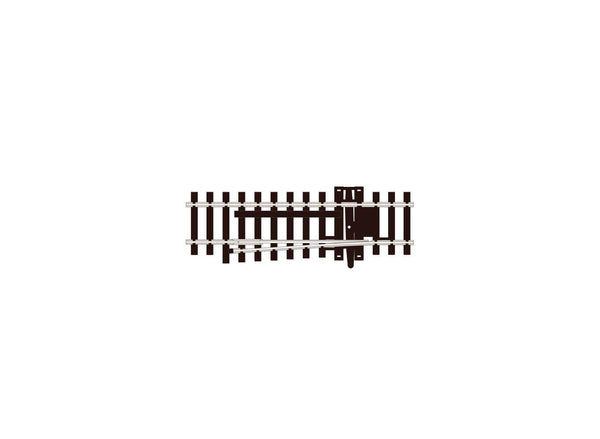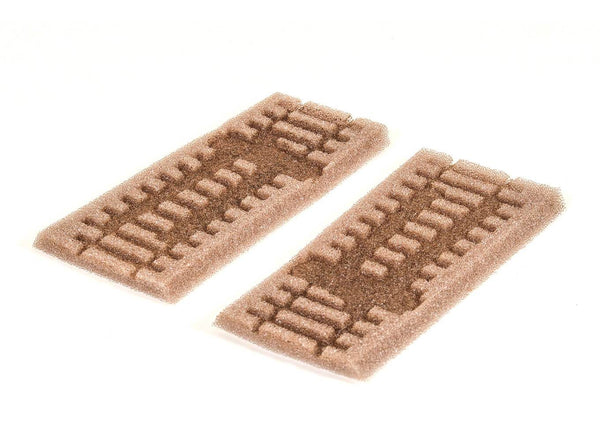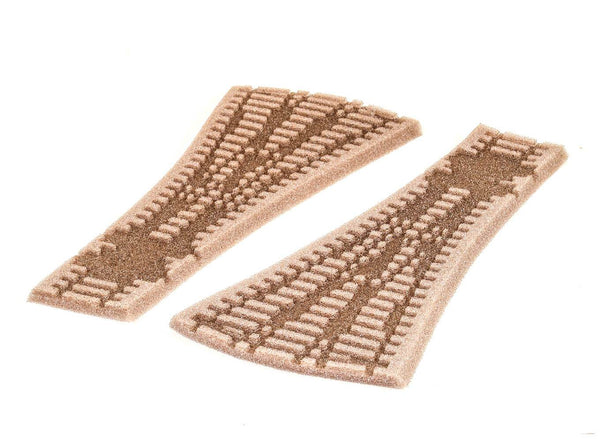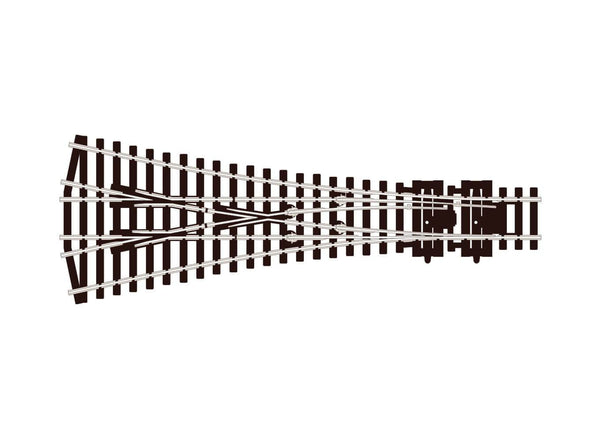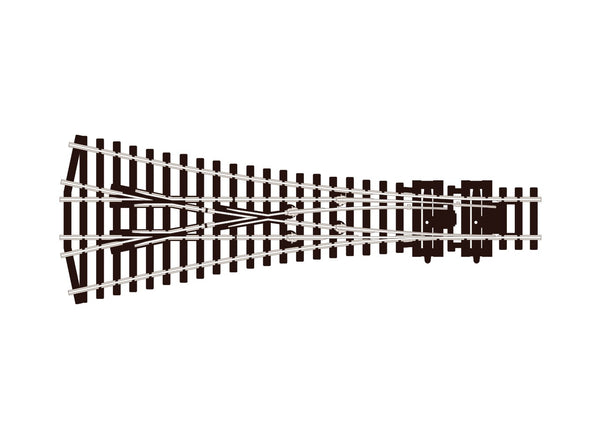BROWSE PECO PRODUCTS
Browse through our complete product portfolio.
43 Products Found
Flexible Track, Concrete Sleeper
Concrete sleeper track has been in use on the railways of Britain since around 1940, usually combined with wooden sleeper turnouts and crossings, and this track is a faithful representation of this design.
If you wish to mix wheel standards on your 00/H0 layout, this is the trackage to choose. Code 100 rail allows flange depths up to 1.6mm which means that both vintage and current stock will run happily together. The wide range of turnouts and crossings in this series includes every type, and the geometry of this range has been cleverly designed to make it easy to build convenient, complex and aesthetically pleasing formations.
Transition Tracks
For use between sections of Code 100 and Code 75 track, so for example could be used to incorporate a Code 75 Asymmetric 3- way Turnout (SL-E199) into a Code 100 layout, or to connect a Code 100 Streamline or Setrack 'fiddle yard' to a Code 75 scenic section.
Normally conductive; although the electrical connections between the 2 rail types can be cut to provide an electrical break. Supplied in a pack of 4.
Curved Turnout, Small Radius, Left Hand
Adapted from the existing PECO Setrack Curved turnout, this brand new development allows us to add a really useful component into the classic Streamline OO/HO Code 100 range. At last we are able to offer a tighter radius turnout for Streamline users, something that has been requested on and off for a long time. 
Curved turnouts are fantastic space savers and their benefits are often overlooked. Given that so many layouts are built to be located in small spaces the use of curved turnouts ought to be greater than it is, so these new Streamline turnouts may well address many concerns that modellers have when planning their model railway.
This turnout has been derived from the existing Setrack curved turnout the geometry departs from the common frog angle adopted by the Streamline system (which is based on a common frog angle of 12 degrees) - this turnout has a 11.25 degree frog angle and the inner radius is just 438mm, or 17.2 inches. This should not be seen as any disadvantage and the real benefit is that they will allow much tighter access where it is needed, such as in restricted places where a layout has to loop around into a fiddle yard, for example.  The standard Streamline curved turnout has a minimum inside radius of 762mm, 30 inches, so the difference is quite clear to see.
Curved Turnout, Small Radius, Right Hand
Adapted from the existing PECO Setrack Curved turnout, this brand new development allows us to add a really useful component into the classic Streamline OO/HO Code 100 range. At last we are able to offer a tighter radius turnout for Streamline users, something that has been requested on and off for a long time. 
Curved turnouts are fantastic space savers and their benefits are often overlooked. Given that so many layouts are built to be located in small spaces the use of curved turnouts ought to be greater than it is, so these new Streamline turnouts may well address many concerns that modellers have when planning their model railway.
This turnout has been derived from the existing Setrack curved turnout the geometry departs from the common frog angle adopted by the Streamline system (which is based on a common frog angle of 12 degrees) - this turnout has a 11.25 degree frog angle and the inner radius is just 438mm, or 17.2 inches. This should not be seen as any disadvantage and the real benefit is that they will allow much tighter access where it is needed, such as in restricted places where a layout has to loop around into a fiddle yard, for example.  The standard Streamline curved turnout has a minimum inside radius of 762mm, 30 inches, so the difference is quite clear to see.
Y Turnout, Medium Radius
16.5mm gauge track in 7mm scale gives an equivalent prototype of 2ft 4 ins, making it a popular choice for modellers, this scale is also known as 0n30 in the USA because this results in a prototype gauge close to 30ins. many modellers find that this scale/gauge allows an ideal combination of scale detail in a relatively small space. For more details on Electrofrog turnouts, see our Wiring the Layout publications Nos 4 and 21.
Y Turnout, Large Radius
If you wish to mix wheel standards on your 00/H0 layout, this is the trackage to choose. Code 100 rail allows flange depths up to 1.6mm which means that both vintage and current stock will run happily together.
The wide range of turnouts and crossings in this series includes every type, and the geometry of this range has been cleverly designed to make it easy to build convenient, complex and aesthetically pleasing formations using combinations of small, medium and large radius turnouts and crossings. Layout plans suggestions can be found in our publications ‘Track Plans for Layouts to Suit all Locations’ (Ref PM-202), ‘60 Plans for Small Railways’ (Ref no PB-3), and ‘Track Plans for Various Locations’ (Ref no PB-66).
Y Turnout, Large Radius
If you wish to mix wheel standards on your 00/H0 layout, this is the trackage to choose. Code 100 rail allows flange depths up to 1.6mm which means that both vintage and current stock will run happily together.
The wide range of turnouts and crossings in this series includes every type, and the geometry of this range has been cleverly designed to make it easy to build convenient, complex and aesthetically pleasing formations using combinations of small, medium and large radius turnouts and crossings. Layout plans suggestions can be found in our publications ‘Track Plans for Layouts to Suit all Locations’ (Ref PM-202), ‘60 Plans for Small Railways’ (Ref no PB-3), and ‘Track Plans for Various Locations’ (Ref no PB-66).
Turnout, Small Radius, Right Hand
If you wish to mix wheel standards on your 00/H0 layout, this is the trackage to choose. Code 100 rail allows flange depths up to 1.6mm which means that both vintage and current stock will run happily together.
The wide range of turnouts and crossings in this series includes every type, and the geometry of this range has been cleverly designed to make it easy to build convenient, complex and aesthetically pleasing formations using combinations of small, medium and large radius turnouts and crossings. Layout plans suggestions can be found in our publications ‘Track Plans for Layouts to Suit all Locations’ (Ref PM-202), ‘60 Plans for Small Railways’ (Ref no PB-3), and ‘Track Plans for Various Locations’ (Ref no PB-66).
Turnout, Small Radius, Right Hand
If you wish to mix wheel standards on your 00/H0 layout, this is the trackage to choose. Code 100 rail allows flange depths up to 1.6mm which means that both vintage and current stock will run happily together.
The wide range of turnouts and crossings in this series includes every type, and the geometry of this range has been cleverly designed to make it easy to build convenient, complex and aesthetically pleasing formations using combinations of small, medium and large radius turnouts and crossings. Layout plans suggestions can be found in our publications ‘Track Plans for Layouts to Suit all Locations’ (Ref PM-202), ‘60 Plans for Small Railways’ (Ref no PB-3), and ‘Track Plans for Various Locations’ (Ref no PB-66).
Turnout, Small Radius, Left Hand
If you wish to mix wheel standards on your 00/H0 layout, this is the trackage to choose. Code 100 rail allows flange depths up to 1.6mm which means that both vintage and current stock will run happily together. The wide range of turnouts and crossings in this series includes every type, and the geometry of this range has been cleverly designed to make it easy to build convenient, complex and aesthetically pleasing formations.
Turnout, Medium Radius, Right Hand
If you wish to mix wheel standards on your 00/H0 layout, this is the trackage to choose. Code 100 rail allows flange depths up to 1.6mm which means that both vintage and current stock will run happily together.
The wide range of turnouts and crossings in this series includes every type, and the geometry of this range has been cleverly designed to make it easy to build convenient, complex and aesthetically pleasing formations using combinations of small, medium and large radius turnouts and crossings. Layout plans suggestions can be found in our publications ‘Track Plans for Layouts to Suit all Locations’ (Ref PM-202), ‘60 Plans for Small Railways’ (Ref no PB-3), and ‘Track Plans for Various Locations’ (Ref no PB-66).
Turnout, Medium Radius, Right Hand
If you wish to mix wheel standards on your 00/H0 layout, this is the trackage to choose. Code 100 rail allows flange depths up to 1.6mm which means that both vintage and current stock will run happily together. The wide range of turnouts and crossings in this series includes every type, and the geometry of this range has been cleverly designed to make it easy to build convenient, complex and aesthetically pleasing formations.
Turnout, Medium Radius, Right Hand
16.5mm gauge track in 7mm scale gives an equivalent prototype of 2ft 4 ins, making it a popular choice for modellers, this scale is also known as 0n30 in the USA because this results in a prototype gauge close to 30ins. many modellers find that this scale/gauge allows an ideal combination of scale detail in a relatively small space. For more details on Electrofrog turnouts, see our Wiring the Layout publications Nos 4 and 21.
Turnout, Medium Radius, Left Hand
If you wish to mix wheel standards on your 00/H0 layout, this is the trackage to choose. Code 100 rail allows flange depths up to 1.6mm which means that both vintage and current stock will run happily together.
The wide range of turnouts and crossings in this series includes every type, and the geometry of this range has been cleverly designed to make it easy to build convenient, complex and aesthetically pleasing formations using combinations of small, medium and large radius turnouts and crossings. Layout plans suggestions can be found in our publications ‘Track Plans for Layouts to Suit all Locations’ (Ref PM-202), ‘60 Plans for Small Railways’ (Ref no PB-3), and ‘Track Plans for Various Locations’ (Ref no PB-66).
Turnout, Medium Radius, Left Hand
If you wish to mix wheel standards on your 00/H0 layout, this is the trackage to choose. Code 100 rail allows flange depths up to 1.6mm which means that both vintage and current stock will run happily together.
The wide range of turnouts and crossings in this series includes every type, and the geometry of this range has been cleverly designed to make it easy to build convenient, complex and aesthetically pleasing formations using combinations of small, medium and large radius turnouts and crossings. Layout plans suggestions can be found in our publications ‘Track Plans for Layouts to Suit all Locations’ (Ref PM-202), ‘60 Plans for Small Railways’ (Ref no PB-3), and ‘Track Plans for Various Locations’ (Ref no PB-66).
Turnout, Medium Radius, Left Hand
16.5mm gauge track in 7mm scale gives an equivalent prototype of 2ft 4 ins, making it a popular choice for modellers, this scale is also known as 0n30 in the USA because this results in a prototype gauge close to 30ins. many modellers find that this scale/gauge allows an ideal combination of scale detail in a relatively small space. For more details on Electrofrog turnouts, see our Wiring the Layout publications Nos 4 and 21.
Turnout, Large Radius, Right Hand
If you wish to mix wheel standards on your 00/H0 layout, this is the trackage to choose. Code 100 rail allows flange depths up to 1.6mm which means that both vintage and current stock will run happily together.
The wide range of turnouts and crossings in this series includes every type, and the geometry of this range has been cleverly designed to make it easy to build convenient, complex and aesthetically pleasing formations using combinations of small, medium and large radius turnouts and crossings. Layout plans suggestions can be found in our publications ‘Track Plans for Layouts to Suit all Locations’ (Ref PM-202), ‘60 Plans for Small Railways’ (Ref no PB-3), and ‘Track Plans for Various Locations’ (Ref no PB-66).
For more details on Electrofrog turnouts, see our Wiring the Layout publications Nos 4 and 21.
Turnout, Large Radius, Right Hand
If you wish to mix wheel standards on your 00/H0 layout, this is the trackage to choose. Code 100 rail allows flange depths up to 1.6mm which means that both vintage and current stock will run happily together.
The wide range of turnouts and crossings in this series includes every type, and the geometry of this range has been cleverly designed to make it easy to build convenient, complex and aesthetically pleasing formations using combinations of small, medium and large radius turnouts and crossings. Layout plans suggestions can be found in our publications ‘Track Plans for Layouts to Suit all Locations’ (Ref PM-202), ‘60 Plans for Small Railways’ (Ref no PB-3), and ‘Track Plans for Various Locations’ (Ref no PB-66).
Turnout, Large Radius, Left Hand
If you wish to mix wheel standards on your 00/H0 layout, this is the trackage to choose. Code 100 rail allows flange depths up to 1.6mm which means that both vintage and current stock will run happily together.
The wide range of turnouts and crossings in this series includes every type, and the geometry of this range has been cleverly designed to make it easy to build convenient, complex and aesthetically pleasing formations using combinations of small, medium and large radius turnouts and crossings. Layout plans suggestions can be found in our publications ‘Track Plans for Layouts to Suit all Locations’ (Ref PM-202), ‘60 Plans for Small Railways’ (Ref no PB-3), and ‘Track Plans for Various Locations’ (Ref no PB-66).
For more details on Electrofrog turnouts, see our Wiring the Layout publications Nos 4 and 21.
Turnout, Large Radius, Left Hand
If you wish to mix wheel standards on your 00/H0 layout, this is the trackage to choose. Code 100 rail allows flange depths up to 1.6mm which means that both vintage and current stock will run happily together.
The wide range of turnouts and crossings in this series includes every type, and the geometry of this range has been cleverly designed to make it easy to build convenient, complex and aesthetically pleasing formations using combinations of small, medium and large radius turnouts and crossings. Layout plans suggestions can be found in our publications ‘Track Plans for Layouts to Suit all Locations’ (Ref PM-202), ‘60 Plans for Small Railways’ (Ref no PB-3), and ‘Track Plans for Various Locations’ (Ref no PB-66).
Rail Joiner
Designed to be used with our 00/H0 Code 100 track systems (Ref nos. SL-100 and 102); also with 0 Gauge Bullhead (SL-700BH) and 0-16.5/0n30 (SL-500) track systems.
Insulated Rail Joiner
Designed to be used with our 00/H0 Code 100 track systems (Ref nos. SL-100 and 102); also with 0 Gauge Bullhead (SL-700BH) and 0-16.5/0n30 (SL-500) track systems.
Design prevents adjacent rails from touching whilst holding them in alignment. Insulated rail joiners are required to provide electrical breaks where Electrofrog turnouts are used, for more details see our Wiring the Layout publications Nos 4 and 21.
Flexible Track, Wooden Sleeper
16.5mm gauge track in 7mm scale gives an equivalent prototype of 2ft 4 ins, making it a popular choice for modellers, this scale is also known as 0n30 in the USA because this results in a prototype gauge close to 30ins. many modellers find that this scale/gauge allows an ideal combination of scale detail in a relatively small space.
Flexible Track, Wooden Sleeper
If you wish to mix wheel standards on your 00/H0 layout, this is the trackage to choose. Code 100 rail allows flange depths up to 1.6mm which means that both vintage and current stock will run happily together.
The wide range of turnouts and crossings in this series includes every type, and the geometry of this range has been cleverly designed to make it easy to build convenient, complex and aesthetically pleasing formations. Layout plans suggestions can be found in our publications ‘Track Plans for Layouts to Suit all Locations’ (Ref PM-202), ‘60 Plans for Small Railways’ (Ref no PB-3), and ‘Track Plans for Various Locations’ (Ref no PB-66).
Flexible Track, Concrete Sleeper
Concrete sleeper track has been in use on the railways of Britain since around 1940, usually combined with wooden sleeper turnouts and crossings, and this track is a faithful representation of this design.
If you wish to mix wheel standards on your 00/H0 layout, this is the trackage to choose. Code 100 rail allows flange depths up to 1.6mm which means that both vintage and current stock will run happily together. The wide range of turnouts and crossings in this series includes every type, and the geometry of this range has been cleverly designed to make it easy to build convenient, complex and aesthetically pleasing formations.
Decoupler RH type
For use with the tension lock couplers fitted to Hornby(TM), Bachmann(TM), Dapol(TM) etc. rolling stock on Peco Streamline Track.
Decoupler Magni-Simplex type
Magnetic uncoupler for use with stock fitted with the Peco Magni Simplex (R-3) couplings.
Decoupler A/HD type
For use with Peco Simplex couplings (R-2) and original Hornby Dublo (TM) couplings. Moulded in brown plastic to resemble check rails. Can also be used with 0-16.5 track.
Curved Turnout, Large Radius, Right Hand
If you wish to mix wheel standards on your 00/H0 layout, this is the trackage to choose. Code 100 rail allows flange depths up to 1.6mm which means that both vintage and current stock will run happily together.
The wide range of turnouts and crossings in this series includes every type, and the geometry of this range has been cleverly designed to make it easy to build convenient, complex and aesthetically pleasing formations using combinations of small, medium and large radius turnouts and crossings. Layout plans suggestions can be found in our publications ‘Track Plans for Layouts to Suit all Locations’ (Ref PM-202), ‘60 Plans for Small Railways’ (Ref no PB-3), and ‘Track Plans for Various Locations’ (Ref no PB-66).
For more details on Electrofrog turnouts, see our Wiring the Layout publications Nos 4 and 21.
Curved Turnout, Large Radius, Right Hand
If you wish to mix wheel standards on your 00/H0 layout, this is the trackage to choose. Code 100 rail allows flange depths up to 1.6mm which means that both vintage and current stock will run happily together.
The wide range of turnouts and crossings in this series includes every type, and the geometry of this range has been cleverly designed to make it easy to build convenient, complex and aesthetically pleasing formations using combinations of small, medium and large radius turnouts and crossings. Layout plans suggestions can be found in our publications ‘Track Plans for Layouts to Suit all Locations’ (Ref PM-202), ‘60 Plans for Small Railways’ (Ref no PB-3), and ‘Track Plans for Various Locations’ (Ref no PB-66).
Curved Turnout, Large Radius, Left Hand
If you wish to mix wheel standards on your 00/H0 layout, this is the trackage to choose. Code 100 rail allows flange depths up to 1.6mm which means that both vintage and current stock will run happily together.
The wide range of turnouts and crossings in this series includes every type, and the geometry of this range has been cleverly designed to make it easy to build convenient, complex and aesthetically pleasing formations using combinations of small, medium and large radius turnouts and crossings. Layout plans suggestions can be found in our publications ‘Track Plans for Layouts to Suit all Locations’ (Ref PM-202), ‘60 Plans for Small Railways’ (Ref no PB-3), and ‘Track Plans for Various Locations’ (Ref no PB-66).
For more details on Electrofrog turnouts, see our Wiring the Layout publications Nos 4 and 21.
Curved Turnout, Large Radius, Left Hand
If you wish to mix wheel standards on your 00/H0 layout, this is the trackage to choose. Code 100 rail allows flange depths up to 1.6mm which means that both vintage and current stock will run happily together.
The wide range of turnouts and crossings in this series includes every type, and the geometry of this range has been cleverly designed to make it easy to build convenient, complex and aesthetically pleasing formations using combinations of small, medium and large radius turnouts and crossings. Layout plans suggestions can be found in our publications ‘Track Plans for Layouts to Suit all Locations’ (Ref PM-202), ‘60 Plans for Small Railways’ (Ref no PB-3), and ‘Track Plans for Various Locations’ (Ref no PB-66).
Crossing, Single Slip
Single slips were often used on double track lines to incorporate a trailing crossover into the access for a siding, goods yard etc.
If you wish to mix wheel standards on your 00/H0 layout, this is the trackage to choose. Code 100 rail allows flange depths up to 1.6mm which means that both vintage and current stock will run happily together.
The wide range of turnouts and crossings in this series includes every type, and the geometry of this range has been cleverly designed to make it easy to build convenient, complex and aesthetically pleasing formations using combinations of small, medium and large radius turnouts and crossings. Layout plans suggestions can be found in our publications ‘Track Plans for Layouts to Suit all Locations’ (Ref PM-202), ‘60 Plans for Small Railways’ (Ref no PB-3), and ‘Track Plans for Various Locations’ (Ref no PB-66).
Crossing, Short
The Short Crossing is double the angle of other track components in this range, this enables it to be used to form scissors formations in conjunction with them. Also, a compact double junction can be formed by using it with 2 short Y turnouts (Overall length 275mm).
If you wish to mix wheel standards on your 00/H0 layout, this is the trackage to choose. Code 100 rail allows flange depths up to 1.6mm which means that both vintage and current stock will run happily together.
The wide range of turnouts and crossings in this series includes every type, and the geometry of this range has been cleverly designed to make it easy to build convenient, complex and aesthetically pleasing formations using combinations of small, medium and large radius turnouts and crossings. Layout plans suggestions can be found in our publications ‘Track Plans for Layouts to Suit all Locations’ (Ref PM-202), ‘60 Plans for Small Railways’ (Ref no PB-3), and ‘Track Plans for Various Locations’ (Ref no PB-66).
Crossing, Long
This unit can be used with small, medium, or large radius turnouts to form a double junction.
If you wish to mix wheel standards on your 00/H0 layout, this is the trackage to choose. Code 100 rail allows flange depths up to 1.6mm which means that both vintage and current stock will run happily together.
The wide range of turnouts and crossings in this series includes every type, and the geometry of this range has been cleverly designed to make it easy to build convenient, complex and aesthetically pleasing formations using combinations of small, medium and large radius turnouts and crossings. Layout plans suggestions can be found in our publications ‘Track Plans for Layouts to Suit all Locations’ (Ref PM-202), ‘60 Plans for Small Railways’ (Ref no PB-3), and ‘Track Plans for Various Locations’ (Ref no PB-66).
Crossing, Double Slip
Double slips can save valuable space at station approaches, junctions etc.
If you wish to mix wheel standards on your 00/H0 layout, this is the trackage to choose. Code 100 rail allows flange depths up to 1.6mm which means that both vintage and current stock will run happily together.
The wide range of turnouts and crossings in this series includes every type, and the geometry of this range has been cleverly designed to make it easy to build convenient, complex and aesthetically pleasing formations using combinations of small, medium and large radius turnouts and crossings. Layout plans suggestions can be found in our publications ‘Track Plans for Layouts to Suit all Locations’ (Ref PM-202), ‘60 Plans for Small Railways’ (Ref no PB-3), and ‘Track Plans for Various Locations’ (Ref no PB-66).
Catch Turnout, Right Hand
The purpose of a Catch Turnout is to derail a vehicle before it rolls out of a siding or branch line on to a main line.
If you wish to mix wheel standards on your 00/H0 layout, this is the trackage to choose. Code 100 rail allows flange depths up to 1.6mm which means that both vintage and current stock will run happily together.
The wide range of turnouts and crossings in this series includes every type, and the geometry of this range has been cleverly designed to make it easy to build convenient, complex and aesthetically pleasing formations using combinations of small, medium and large radius turnouts and crossings. Layout plans suggestions can be found in our publications ‘Track Plans for Layouts to Suit all Locations’ (Ref PM-202), ‘60 Plans for Small Railways’ (Ref no PB-3), and ‘Track Plans for Various Locations’ (Ref no PB-66).
Catch Turnout, Left Hand
The purpose of a Catch Turnout is to derail a vehicle before it rolls out of a siding or branch line on to a main line.
If you wish to mix wheel standards on your 00/H0 layout, this is the trackage to choose. Code 100 rail allows flange depths up to 1.6mm which means that both vintage and current stock will run happily together.
The wide range of turnouts and crossings in this series includes every type, and the geometry of this range has been cleverly designed to make it easy to build convenient, complex and aesthetically pleasing formations using combinations of small, medium and large radius turnouts and crossings. Layout plans suggestions can be found in our publications ‘Track Plans for Layouts to Suit all Locations’ (Ref PM-202), ‘60 Plans for Small Railways’ (Ref no PB-3), and ‘Track Plans for Various Locations’ (Ref no PB-66).
Ballast Inlay Catch Point, Right Hand
Moulded foam ballast inlay in a realistic brown colour. Moulded units fit Turnouts and Crossings, and rolls are available for plain track (Streamline and Setrack). This inlay system adds extra realism as well as giving quieter, smoother running. Suitable for Code 100 and Code 75 track.
Ballast Inlay Catch Point, Left Hand
Moulded foam ballast inlay in a realistic brown colour. Moulded units fit Turnouts and Crossings, and rolls are available for plain track (Streamline and Setrack). This inlay system adds extra realism as well as giving quieter, smoother running. Suitable for Code 100 and Code 75 track.
Ballast Inlay 3 Way Turnout, Medium Radius
Moulded foam ballast inlay in a realistic brown colour. Moulded units fit Turnouts and Crossings, and rolls are available for plain track (Streamline and Setrack). This inlay system adds extra realism as well as giving quieter, smoother running. Suitable for Code 100 track.
3 Way Turnout, Medium Radius
The 3 way turnout is an ideal way to save space on station approaches, junctions etc.
If you wish to mix wheel standards on your 00/H0 layout, this is the trackage to choose. Code 100 rail allows flange depths up to 1.6mm which means that both vintage and current stock will run happily together.
The wide range of turnouts and crossings in this series includes every type, and the geometry of this range has been cleverly designed to make it easy to build convenient, complex and aesthetically pleasing formations using combinations of small, medium and large radius turnouts and crossings. Layout plans suggestions can be found in our publications ‘Track Plans for Layouts to Suit all Locations’ (Ref PM-202), ‘60 Plans for Small Railways’ (Ref no PB-3), and ‘Track Plans for Various Locations’ (Ref no PB-66).
For more details on Electrofrog turnouts, see our Wiring the Layout publications Nos 4 and 21.
3 Way Turnout, Medium Radius
The 3 way turnout is an ideal way to save space on station approaches, junctions etc.
If you wish to mix wheel standards on your 00/H0 layout, this is the trackage to choose. Code 100 rail allows flange depths up to 1.6mm which means that both vintage and current stock will run happily together.
The wide range of turnouts and crossings in this series includes every type, and the geometry of this range has been cleverly designed to make it easy to build convenient, complex and aesthetically pleasing formations using combinations of small, medium and large radius turnouts and crossings. Layout plans suggestions can be found in our publications ‘Track Plans for Layouts to Suit all Locations’ (Ref PM-202), ‘60 Plans for Small Railways’ (Ref no PB-3), and ‘Track Plans for Various Locations’ (Ref no PB-66).










